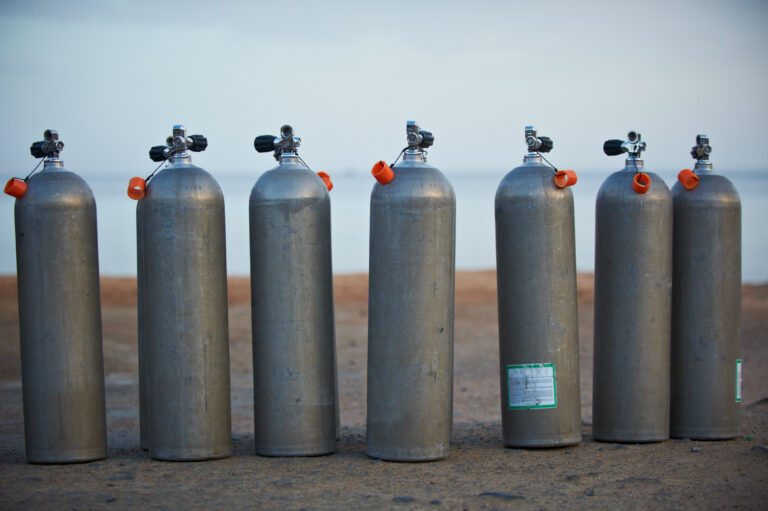What is a Hang Tank?
A hang tank, also known as a decompression tank, is an essential piece of scuba diving equipment designed to enhance diver safety and convenience during decompression stops. This additional air source is typically staged at the rear of a dive boat and is accessible in case of emergencies. Decompression stops, a crucial aspect of scuba diving, are planned pauses that divers make during their ascent to the surface. These stops allow dissolved nitrogen in the body to be gradually released, preventing the potentially fatal condition known as decompression sickness (DCS) or “the bends.” Hang tanks play a critical role in ensuring that divers have access to a reliable air supply during these stops.
History of Hang Tanks
The concept of hang tanks emerged in the early days of recreational and technical scuba diving, as divers sought to mitigate the risks associated with deep diving and decompression. Diving pioneers like Jacques Cousteau and Hans Hass recognized the importance of decompression stops and began to develop techniques and equipment to facilitate these pauses. By the 1960s, the use of hang tanks became an established practice among divers, particularly those engaging in deeper and more extended excursions. Over time, advancements in scuba technology and diving practices have further refined the use of hang tanks, making them an indispensable tool for safe diving.
Utility of Hang Tanks
Hang tanks are especially useful for divers conducting deep or extended dives. These dives often require multiple decompression stops, which can deplete the diver’s primary air supply. The hang tank provides a backup air source, allowing divers to conserve their primary tank for the remainder of the ascent.
Moreover, hang tanks can serve as a crucial lifeline in case of emergencies. Equipment malfunctions, air depletion, or diver disorientation can all lead to potentially hazardous situations. Having a hang tank readily accessible at a decompression stop can provide the necessary air supply for a diver in distress, enabling them to complete their decompression stops and safely ascend to the surface.
Technical Aspects of Hang Tanks
A hang tank is typically a smaller, portable scuba tank containing compressed air or an enriched air mixture (e.g., nitrox). The size and capacity of the tank may vary depending on the depth and duration of the dive, as well as the diver’s personal preference. Common sizes include 19, 30, or 40 cubic feet (ft³), with 30 ft³ tanks being the most popular choice.
The hang tank is equipped with a regulator, pressure gauge, and often an additional low-pressure inflator hose to inflate the diver’s buoyancy compensator (BC). These components are crucial for monitoring the tank’s air supply and ensuring a smooth flow of air to the diver during decompression stops.
Securing and Staging Hang Tanks
Properly securing and staging hang tanks is essential for ensuring easy access during a dive. Hang tanks are typically attached to the dive boat’s stern using a sturdy line or strap. The line should be long enough to allow the tank to be suspended at the appropriate depth for the planned decompression stop(s).
To stage the hang tank, divers must first secure it to the line with a reliable attachment system, such as a stainless steel bolt snap or carabiner. The tank should then be suspended at the designated depth, with the regulator and pressure gauge facing outward for easy access. Divers must ensure that the hang tank remains clear of any boat propellers or other potential hazards to prevent damage or entanglement.
Hang Tank Best Practices
Regular inspection
Like all scuba equipment, hang tanks and their components should be regularly inspected for signs of wear, damage, or corrosion. Ensuring that the tank, regulator, and pressure gauge are in good working condition is crucial for maintaining diver safety.
Proper maintenance
Hang tanks should be serviced according to the manufacturer’s recommendations. This includes periodic hydrostatic testing and visual inspections of the tank, as well as servicing the regulator and other components as needed.
Air quality
The air or gas mixture within the hang tank should be regularly tested for quality and contamination. Breathing contaminated air can lead to serious health complications and compromise diver safety.
Gas management
Divers should practice proper gas management, accounting for the air supply in both their primary and hang tanks. This includes planning dives according to the available air supply and monitoring consumption throughout the dive.
Training and certification
Divers planning to use hang tanks should complete appropriate training and certification courses. These courses provide essential knowledge and skills for using hang tanks safely and effectively.
Communication and teamwork
Divers should communicate their hang tank usage and decompression plans with their dive buddy or team. This ensures that all members are aware of the location of the hang tank and can assist in case of emergencies.
Emergency preparedness
Divers should be prepared to handle emergencies that may arise during a dive, including equipment malfunctions, low air situations, or diver disorientation. Knowing how to access and use a hang tank in these situations is essential for diver safety.
Hang tanks have become a vital component of safe scuba diving practices, particularly for deep and extended dives. They provide a backup air supply during decompression stops, allowing divers to conserve their primary air and ensure a safe ascent. By understanding the history, utility, and technical aspects of hang tanks, divers can make informed decisions about their use and implementation in dive planning. Adhering to best practices for hang tank maintenance, gas management, and emergency preparedness can significantly enhance diver safety and contribute to a more enjoyable diving experience.

















